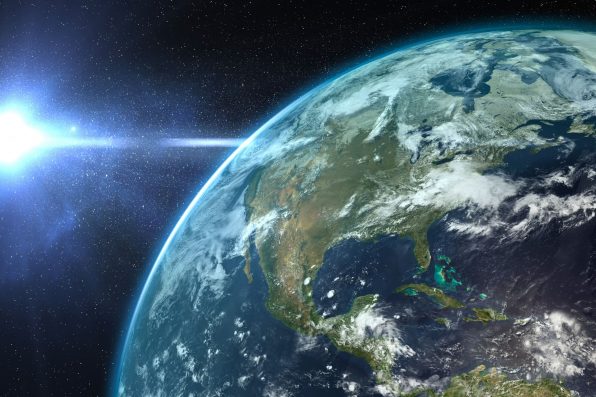Scientists Have Pieced Together Earth’s Climate History, Showing How Our Planet’s Temperature Has Shifted Over About 485 Million Years

Over the course of our planet’s long history, Earth’s climate has seen some dramatic shifts—and it will only continue to change.
Our world is warming quickly due to large amounts of greenhouse gases being released into the atmosphere. They are pushing Earth’s temperatures higher and higher, making natural disasters like wildfires increasingly common.
Experts have been analyzing the fossil record to try to learn more about what Earth’s future has in store for us as human-induced climate change persists.
By studying data on prehistoric temperatures and creating climate models, researchers have been able to piece together Earth’s climate history over the span of about 485 million years.
Their research efforts began in 2018. Paleontologists Scott Wing and Brian Huber wanted to incorporate a temperature curve in the “Deep Time” exhibition at the Smithsonian’s National Museum of Natural History. However, no one had ever managed to produce an accurate, comprehensive representation of Earth’s surface temperatures during the past 539 million years.
So, Wing, Huber, and a team of climate scientists worked together to compile information about Earth’s climate history. They used various methods to estimate prehistoric temperatures. Some scientists investigated ice cores with bubbles trapped inside because the chemical composition of the bubbles could offer hints as to what the ancient climate was like.
They also compared oxygen isotopes in prehistoric fossils and sediment layers to estimate whether Earth was warmer or cooler at certain times. The anatomy of fossilized leaves can even help guide temperature estimates.
For instance, a leaf with long, smooth edges allows water to run off its surface, indicating that it was from a warm, humid habitat. On the other hand, a leaf with shorter, more jagged edges is likely from a cooler climate.
The team assembled a database of more than 150,000 estimates of ancient temperatures. Researchers from the University of Bristol in England, who collaborated on the project, created over 850 climate models that simulated weather conditions during the Phanerozoic period.

vectorfusionart – stock.adobe.com – illustrative purposes only
Combining the temperature estimates and the climate models helped generate a bigger picture of the ancient Earth’s climate shifts. The results covered Earth’s temperature within the past 485 million years and most of the Phanerozoic.
The Phanerozoic saw an increase in sea creatures, the growth of plants on land, and multiple mass extinctions.
Throughout the Phanerozoic, the planet’s average surface temperature spanned 51.8 degrees Fahrenheit to 96.8 degrees Fahrenheit.
Overall, the planet was warmer more often than it was cooler. During the past 485 million years, the average surface temperature fluctuated between hot and cold periods instead of staying consistent within a specific range.
The warm temperatures were linked to carbon dioxide. When carbon dioxide levels in the atmosphere increased, so did the temperatures.
The association was most notable around the time of mass extinctions when events like volcanic eruptions occurred, releasing large amounts of carbon dioxide into the atmosphere.
The research has highlighted the need to understand the extent to which carbon dioxide affects Earth’s climate.
Keeping track of and maintaining Earth’s temperature is essential for our survival. Today, Earth is cooler compared to some ancient periods.
The planet has a mean surface temperature of 59 degrees Fahrenheit, but that is likely to rise as more greenhouse gases are released. It is up to humans to do their part to prevent the planet from warming further.
The study was published in the journal Science.
Sign up for Chip Chick’s newsletter and get stories like this delivered to your inbox.
More About:News